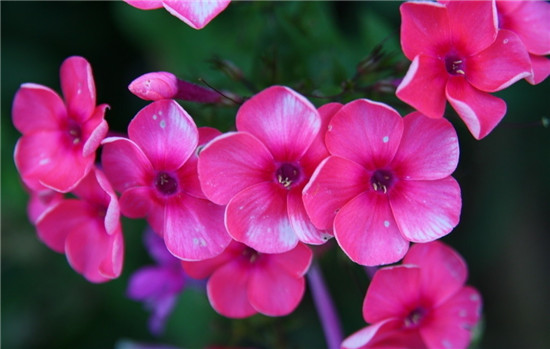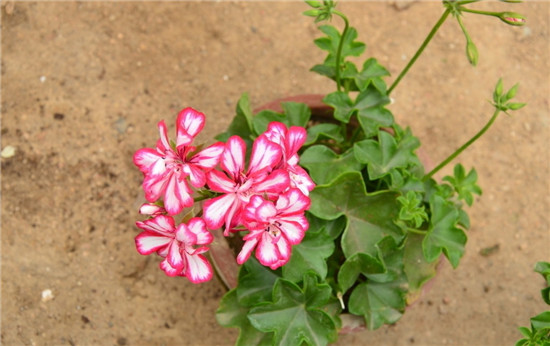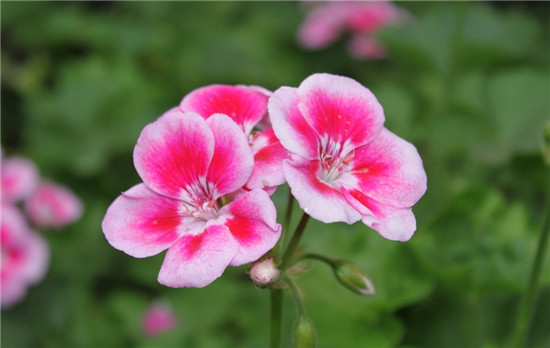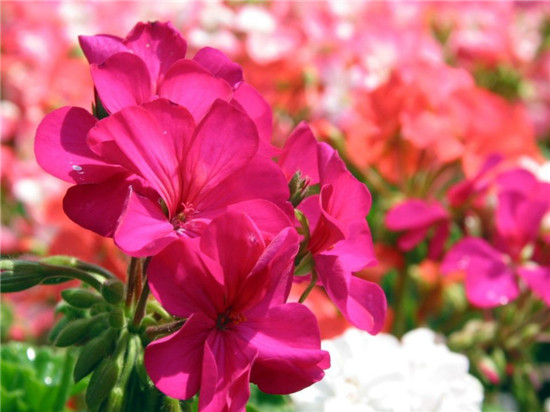Planting and maintenance of geranium
Pelargonium, also known as Shilahong, is a perennial herbaceous flower. Because the flowers are as dense as balls, it is also known as hydrangea. Next, let's take a look at the planting and maintenance of geraniums.

Growth habits of Pelargonium
Pelargonium is strong in nature and rarely shy of diseases and insect pests; it is also adaptable and can grow in all kinds of soil, but it can grow best in sand rich in humus; it is warm, slightly resistant to drought, afraid of stagnant water, and intolerant of hot summer heat and hot sun exposure.
Plants stop growing in summer, leaves aging, showing a semi-dormant shape, at this time can be transferred to the outdoor ☆ forbidden ☆ shade, stop the application of liquid fertilizer, watering on time, the pot will be put down in rainy days to prevent stagnant water rotting roots.
The winter temperature is not lower than 10 ℃ and can withstand 5 ℃ low temperature in a short time. The geranium likes to be warm in winter and cool in summer. It can blossom normally when the indoor temperature is kept at 10-15 ℃ every day in winter and the temperature at night is above 8 ℃. But the optimum temperature is 15-20 ℃. Geraniums like dryness and hate dampness, and should not be watered too much in winter. See dry and wet.
When the soil is wet, the stem is tender, which is not conducive to the sprouting and opening of flower branches; long-term excessive humidity will cause plants to grow too long, flower branches will move up, and the leaves will gradually yellow and fall off. Geraniums need plenty of sunlight for a long time, so they must be placed in the sun in winter. Lack of light, long stems and leaves, soft pedicels and poor inflorescence; buds in low light often bloom poorly and wither ahead of time. Geraniums do not like big fertilizer, too much fertilizer will make geraniums grow too prosperous and not conducive to flowering.

In order to bloom luxuriantly, watering thin book fertilizer water (rotten bean cake water) every 1-2 weeks with 800-fold potassium dihydrogen phosphate solution every 7-15 days can promote normal flowering. Cutting off the abortive flower stem in time after flowering can increase the light between plants, induce the germination of new leaves and draw out new flower stems.
Classification and identification skills of geraniums
Horseshoe geranium: it gets its name because of the obvious dark brown horseshoe lines in its leaf edge. The petals are of the same color, dark red to white; the upper two petals are very short and the petals are narrowly cuneate. This species produces many varieties of colored leaves.
Home geranium: also known as butterfly geranium, foreign butterfly. The whole plant has soft hairs. There are no hoof lines on the leaves, and the teeth of the leaf margin are sharp and irregular. The flowers are large, with white, light red, lavender and other colors. It gets its name because of two red or purple patches on its petals.
Pelargonium: also known as Fujimoto geranium, Ivy leaf pelargonium. The stem is semi-trailing, and the plant is ten-day or scandent. Leaves peltate, slightly glossy. The flowers are small, 4-8 flowers gather, and the flowers are white, pink, red, purple and pink. Flowering in winter and spring.

Aromatic geranium: also known as scented geranium, round-leaf geranium. The stem is thin and weak, and the new branches and leaves are often clustered at the top of the stem. Umbels, flowers small, white, upper two petals with red-purple markings. Touch the leaves with your hands. That is, emit an attractive fragrance.
Fragrant leaf geranium: also known as touch incense. Semi-shrub. Leaves palmate, 5-7-parted, lobes pinnately lobed again. The flowers are pink or light red, with purplish red markings in the center, and the upper two petals are larger. Flowering in summer.
Chrysanthemum leaf pelargonium: stems with long hairs. The leaves are palmately parted, and the lobes are subdivided into linear shapes. The whole plant is covered with white powder. The flowers are rose-red with purple spots and stripes. Flowering in summer.
Culture methods of geraniums
1. Soil: geranium has strong adaptability and can grow in all kinds of soil, but the sandy loam soil rich in humus grows best.
2. Watering: geraniums like dryness, hate dampness, and should not be watered too much in winter. When the soil is wet, the stem is tender, which is not conducive to the sprouting and opening of flower branches; long-term excessive humidity will cause plants to grow too long, flower branches will move up, and the leaves will gradually yellow and fall off.
3. Sunshine: geraniums need plenty of sunlight during their growing season, so they must be placed in the sun in winter. Lack of light, long stems and leaves, soft pedicels and poor inflorescence; buds in low light often bloom poorly and wither ahead of time.

4. Temperature: the geranium likes to be warm in winter and cool in summer. It can blossom normally when the indoor temperature is kept at 10-15 ℃ every day in winter and the temperature at night is above 8 ℃. But the optimum temperature is 15-20 ℃.
5, fertilization: geraniums do not like big fertilizer, too much fertilizer will make geraniums grow too prosperous and not conducive to flowering. In order to bloom luxuriantly, watering dilute book fertilizer water (rotten bean cake water) every 1-2 weeks with 800-fold potassium dihydrogen phosphate solution every 7-10 days can promote normal flowering.
6. Insect pests: geraniums are poorly ventilated and too humid, and are prone to leaf spot and Fusarium wilt. After discovery, pay attention to ventilation, immediately remove sick flowers and leaves to prevent infection, and spray the same amount of Bordeaux solution to prevent and cure. The main pests are red spiders and whitefly, which can be sprayed with 1000 times of omethoate emulsion.
7. Pruning: pruning in order to promote more flowering of the geranium with more branches, it is necessary to pick the heart of the plant many times to promote it to increase branches and budding. After shedding the flowers, cut off the residual flowers at the right time, cut off the too dense and thin branches, so as not to consume too much nutrients, but it is cold in winter and should not be re-cut.
These are all the contents of the planting and conservation of geraniums that I have summarized for you. I hope this article can help you. Please continue to follow us.
To prevent infection, and spray the same amount of Bordeaux solution for prevention and treatment. The main pests are red spiders and whitefly, which can be sprayed with 1000 times of omethoate emulsion.
7. Pruning: pruning in order to promote more flowering of the geranium with more branches, it is necessary to pick the heart of the plant many times to promote it to increase branches and budding. After shedding the flowers, cut off the residual flowers at the right time, cut off the too dense and thin branches, so as not to consume too much nutrients, but it is cold in winter and should not be re-cut.
These are all the contents of the planting and conservation of geraniums that I have summarized for you. I hope this article can help you. Please continue to follow us.
Related
- Wuhan Hospital Iron Tree Blooming Result Was Instantly Frightened by the Gardener Master
- Which variety of camellia is the most fragrant and best? Which one do you like best?
- What is the small blue coat, the breeding methods and matters needing attention of the succulent plant
- Dormancy time and maintenance management of succulent plants during dormancy
- Minas succulent how to raise, Minas succulent plant pictures
- What are the varieties of winter succulent plants
- How to raise succulent plants in twelve rolls? let's take a look at some experience of breeding twelve rolls.
- Attention should be paid to water control for succulent plants during dormant period (winter and summer)
- Watering experience of twelve rolls of succulent plants
- Techniques for fertilizing succulent plants. An article will let you know how to fertilize succulent plants.



